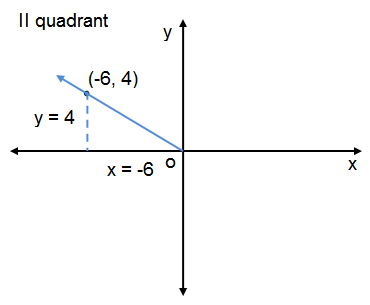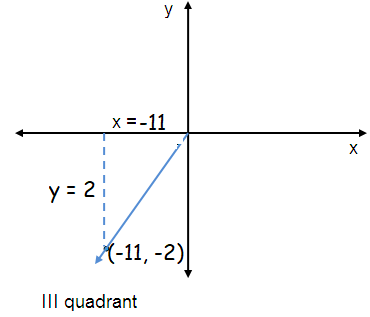THE GIVEN POINT LIES ON THE TERMINAL SIDE EVALUATING TRIG FUNCTIONS
Subscribe to our ▶️ YouTube channel 🔴 for the latest videos, updates, and tips.
To evaluate the given trigonometric function given at a point, we have to follow the steps given below.
Step 1 :
Consider the terminal side, in which quadrant it lies. Draw the perpendicular from the terminal point to the x-axis.
Step 2 :
Using ASTC formula, we can fix the sign of the trigonometric ratio that we are going to evaluate.
|
1st quadrant 2nd quadrant 3rd quadrant 4th quadrant |
All trigonometric ratios are positive sin θ and cosec θ only positive tan θ and cot θ only positive cos θ and sec θ only positive |
Step 3 :
Evaluate hypotenuse if it is needed to evaluate the trigonometric ratio.
Use the given point on the terminal side of angle θ to find the value of the trigonometric function indicated.
Problem 1 :
tan θ ; (8, 18)
Solution :

Since the terminal side lies in the first quadrant, all trigonometric ratios will be positive.
tan θ = opposite/adjacent
= 18/8
tan θ = 9/4
Problem 2 :
sec θ ; (√5, -2)
Solution :

Since the terminal side lies in the fourth quadrant, for cosine θ and its reciprocal sec θ are positive.
sec θ = hypotenuse/adjacent
Let 'r' be the hypotenuse.
By using Pythagorean theorem.
r2 = x2 + y2
r2 = (√5)2 + (-2)2
r2 = 5 + 4
r2 = 9
r = 3
sec θ = 3/√5
Problem 3 :
cos θ ; (√19, 9)
Solution :

Since the terminal side lies in the first quadrant, all trigonometric ratios will be positive.
cos θ = adjacent/hypotenuse
Let 'r' be the hypotenuse.
By using Pythagorean theorem.
r2 = x2 + y2
r2 = (√19)2 + (9)2
r2 = 19 + 81
r2 = 100
r = 10
cos θ = √19/10
Problem 4 :
sin θ ; (3, -4)
Solution :

Since the terminal side lies in the fourth quadrant, for cosine θ and its reciprocal sec θ are positive.
sin θ = opposite/hypotenuse
Let 'r' be the hypotenuse.
By using Pythagorean theorem.
r2 = x2 + y2
r2 = 32 + (-4)2
r2 = 9 + 16
r2 = 25
r = 5
sin θ = -4/5
Problem 5 :
sin θ ; (-6, 4)
Solution :

Since the terminal side lies in the second quadrant, for sin θ and its reciprocal cosec θ are positive.
sin θ = opposite/hypotenuse
Let 'r' be the hypotenuse.
By using Pythagorean theorem.
r2 = x2 + y2
r2 = (-6)2 + (4)2
r2 = 36 + 16
r2 = 52
r = √52
= √(13 × 4)
= 2√13
sin θ = 4/2√13
sin θ = 2/√13
Problem 6 :
cos θ ; (2, -2)
Solution :

Since the terminal side lies in the fourth quadrant, for cosine θ and its reciprocal sec θ are positive.
cos θ = adjacent/hypotenuse
Let 'r' be the hypotenuse.
By using Pythagorean theorem.
r2 = x2 + y2
r2 = 22 + (-2)2
r2 = 4 + 4
r2 = 8
r = √8
cos θ = 2/√8
= 2/√(4 × 2)
= 2/2√2
cos θ = 1/√2
Problem 7 :
cot θ ; (-7, √15)
Solution :

Since the terminal side lies in the second quadrant, for sin θ and its reciprocal cosec θ are positive.
cot θ = adjacent/opposite
= √15/-7
Problem 8 :
cos θ ; (-5, -12)
Solution :

Since the terminal side lies in the third quadrant, for tan θ and its reciprocal cot θ are positive.
cos θ = adjacent/hypotenuse
Let 'r' be the hypotenuse.
By using Pythagorean theorem.
r2 = x2 + y2
r2 = (-5)2 + (-12)2
r2 = 25 + 144
r2 = 169
r = 13
cos θ = -5/13
Problem 9 :
sin θ ; (-√7, 3)
Solution :

Since the terminal side lies in the second quadrant, for sin θ and its reciprocal cosec θ are positive.
sin θ = opposite/hypotenuse
Let 'r' be the hypotenuse.
By using Pythagorean theorem.
r2 = x2 + y2
r2 = (-√7)2 + (3)2
r2 = 7 + 9
r2 = 16
r = 4
sin θ = 3/4
Problem 10 :
tan θ ; (-11, -2)
Solution :

Since the terminal side lies in the third quadrant, for tan θ and its reciprocal cot θ are positive.
tan θ = opposite/adjacent
= -2/-11
tan θ = 2/11
Subscribe to our ▶️ YouTube channel 🔴 for the latest videos, updates, and tips.
Recent Articles
-
Finding Range of Values Inequality Problems
May 21, 24 08:51 PM
Finding Range of Values Inequality Problems -
Solving Two Step Inequality Word Problems
May 21, 24 08:51 AM
Solving Two Step Inequality Word Problems -
Exponential Function Context and Data Modeling
May 20, 24 10:45 PM
Exponential Function Context and Data Modeling